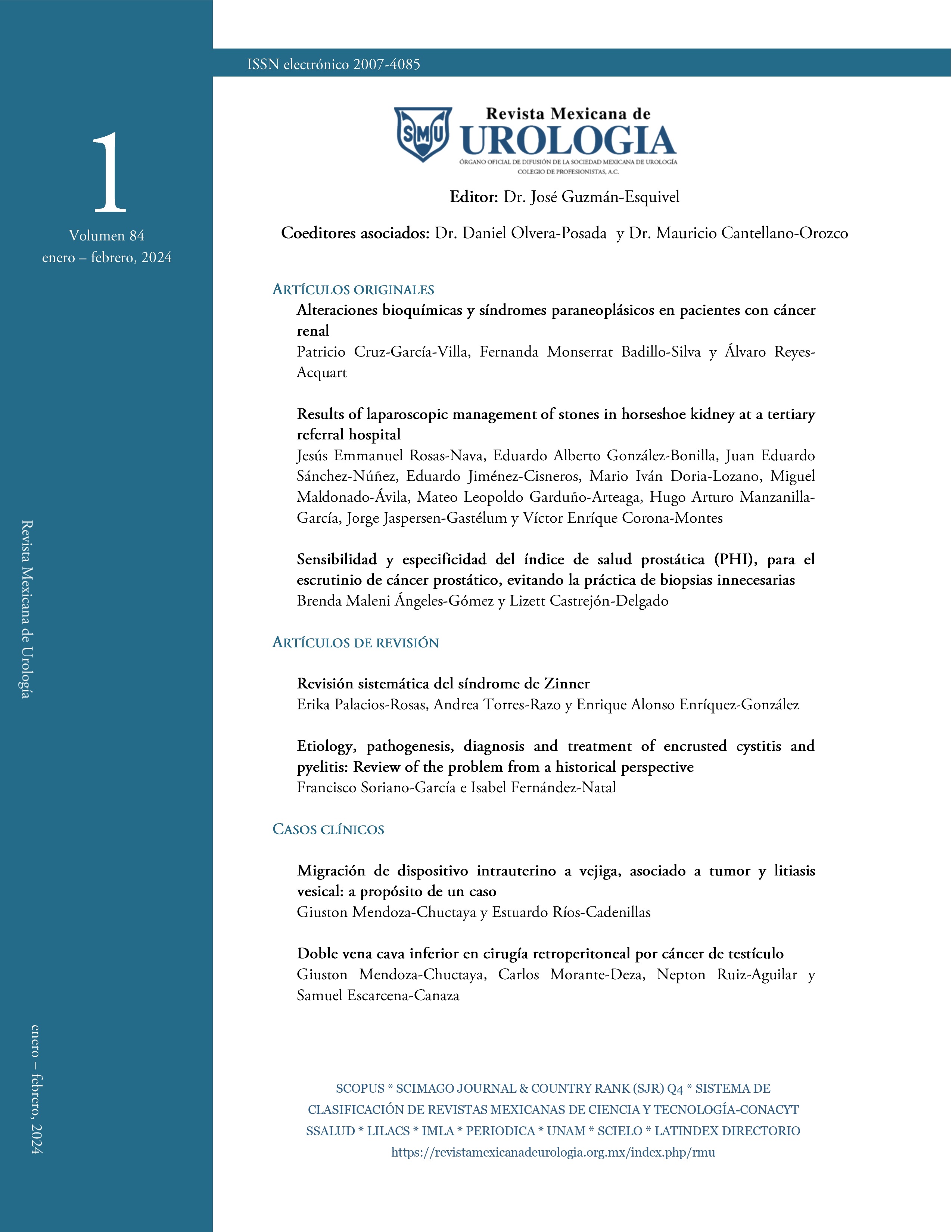Results of laparoscopic management of stones in horseshoe kidney at a tertiary referral hospital
DOI:
https://doi.org/10.48193/5jrzw956Keywords:
Horseshoe Kidney, Kidney Stone, Laparoscopic pyelolithotomyAbstract
The management of kidney stones in patients with horseshoe kidney is a challenge for all urologists, given the low prevalence of the anomaly. There are very few reports of treatment through laparoscopic pyelolithotomy in the literature. Our aim was to share the results and experience obtained in the treatment of stones in horseshoe kidney through transperitoneal laparoscopic pyelolithotomy.
Methodology: A retrospective, observational, cross-sectional, analytic study was conducted on patients diagnosed with horseshoe kidney and kidney stones, confirmed by non-contrast abdominal tomography, and treated through transperitoneal laparoscopic pyelolithotomy, within the time frame of January 2010 and January 2020.
Results: There were 4 cases of renal pelvic stones in horseshoe kidney, all of which were men. Mean patient age was 33.5 years, mean BMI 32.25 kg/m2, mean surgery duration 125 minutes, mean blood loss 55 ml, and mean hospital stay 2.75 days. The stone-free rate was 100 %. Blood loss and age, blood loss and stone size, and BMI and surgery duration were significantly correlated.
Conclusions: Based on our experience, transperitoneal laparoscopic pyelolithotomy is an excellent alternative for treating kidney stones in patients with horseshoe kidney.
References
Symons SJ, Ramachandran A, Kurien A, Baiysha R, Desai MR. Urolithiasis in the horseshoe kidney: a single‐centre experience. BJU International. 2008;102(11): 1676–1680. https://doi.org/10.1111/j.1464-410x.2008.07987.x.
Olcucuoglu E, Camtosun A, Bicer S, Bayraktar AM. Laparoscopic Pyelolithotomy in a Horseshoe Kidney. Türk Üroloji Dergisi/Turkish Journal of Urology. 2014;40(4): 240–244. https://doi.org/10.5152/tud.2014.73604.
Evans WP, Resnick MI. Horseshoe kidney and urolithiasis. The Journal of Urology. 1981;125(5): 620–621. https://doi.org/10.1016/s0022-5347(17)55139-3.
Wang X, Li S, Liu T, Guo Y, Yang Z. Laparoscopic Pyelolithotomy Compared to Percutaneous Nephrolithotomy as Surgical Management for Large Renal Pelvic Calculi: A Meta-Analysis. Journal of Urology. 2013;190(3): 888–893. https://doi.org/10.1016/j.juro.2013.02.092.
Yohannes P, Smith AD. The endourological management of complications associated with horseshoe kidney. J Urol 2002; 168: 5–8. https://doi.org/10.1016/S0022-5347(05)64819-7
Gaur DD, Agarwal DK, Purohit KC, Darshane AS. Retroperitoneal Laparoscopic Pyelolithotomy. Journal of Urology. 1994;151(4): 927–929. https://doi.org/10.1016/s0022-5347(17)35124-8
Nambirajan T, Jeschke S, Albqami N, Abukora F, Leeb K, Janetschek G. Role of Laparoscopy in Management of Renal Stones: Single-Center Experience and Review of Literature. Journal of Endourology. 2005;19(3): 353–359. https://doi.org/10.1089/end.2005.19.353
Maheshwari PN, Bhandarkar DS, Shah RS, Andankar MG, Saple AL. Laparoscopy-Assisted Transperitoneal Percutaneous Nephrolithotomy for Recurrent Calculus in Isthmic Calix of Horseshoe Kidney. Journal of Endourology. 2004;18(9): 858–861. https://doi.org/10.1089/end.2004.18.858
Kramer BA, Hammond L, Schwartz BF. Laparoscopic Pyelolithotomy: Indications and Technique. Journal of Endourology. 2007;21(8): 860–861. https://doi.org/10.1089/end.2006.0410.
Cabrera PM, Cáceres F, García-Tello A, García-Mediero JM, Arconada J, Angulo JC. Pielolitectomía por puerto único umbilical sobre riñón en herradura: una nueva indicación. Actas Urológicas Españolas. 2012;36(2): 121–125. https://doi.org/10.1016/j.acuro.2011.10.003.
Haghighi R, Razi A, Haghighi A, Ebrahimipour N, Teimouri A. Laparoscopy-Assisted Transperitoneal Percutaneous Nephrolithotomy for the Treatment of Renal Stones in a Horseshoe Kidney. Research and Reports in Urology. 2020;Volume 12: 49–52. https://doi.org/10.2147/rru.s241007.
Downloads
Published
Issue
Section
License
Copyright (c) 2024 Revista Mexicana de Urología

This work is licensed under a Creative Commons Attribution-NonCommercial-NoDerivatives 4.0 International License.






